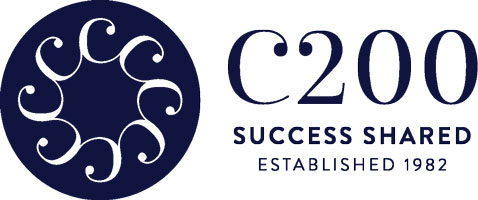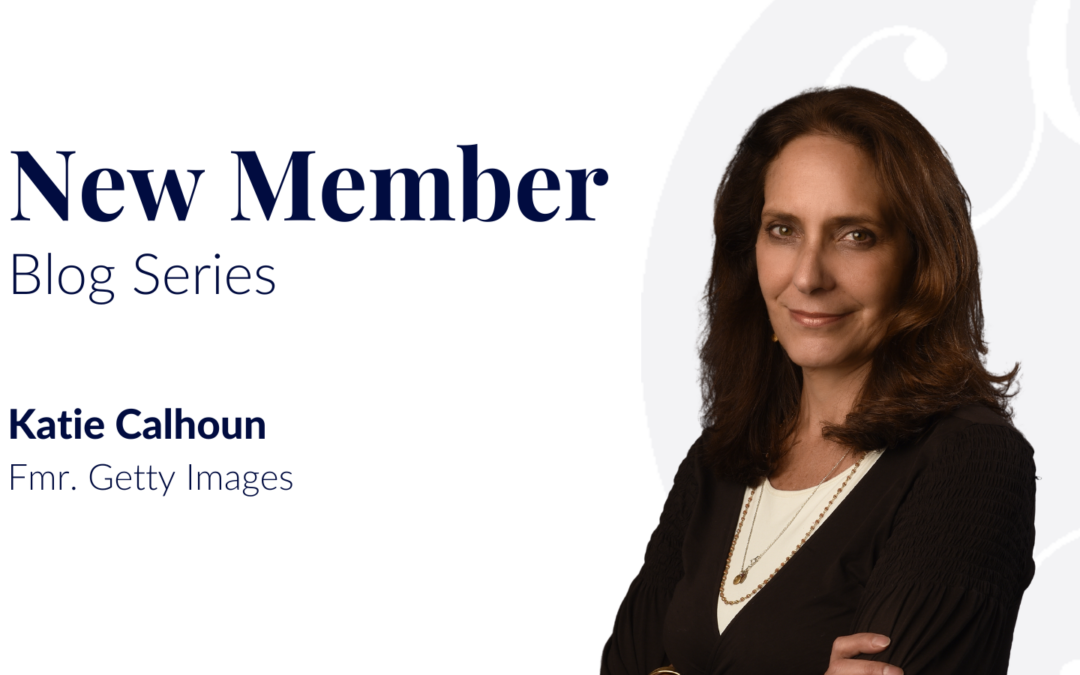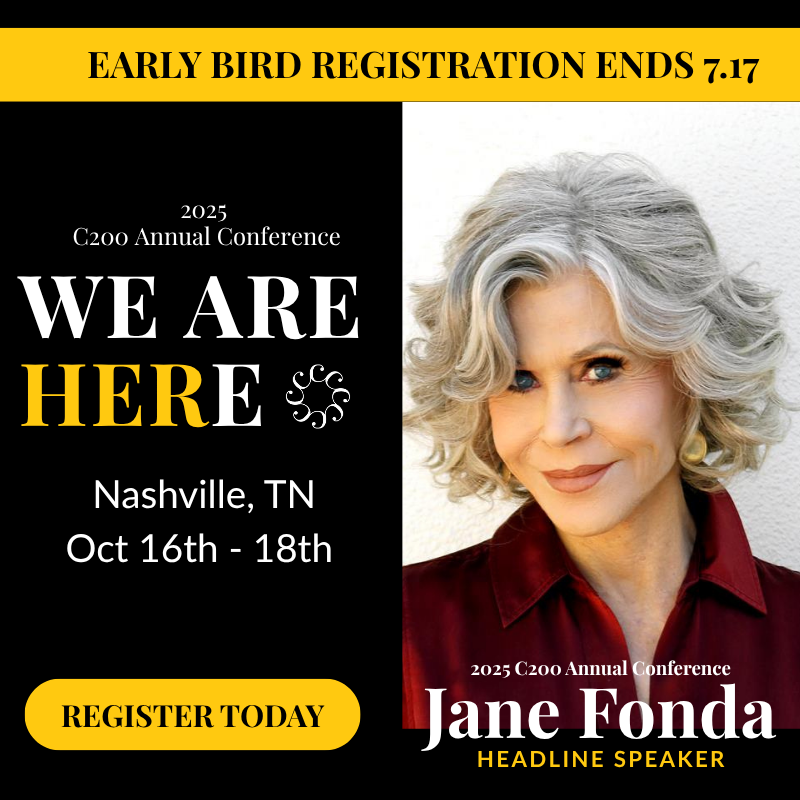Katie Calhoun is an international sales leader with expertise in strategic partnerships and content strategy. She recently concluded a 17-year tenure at Getty Images as VP of Sales and Regional Marketing where she drove Getty’s enterprise business through phenomenal growth, elevating the brand and securing the company’s position as a market leader for visual content. She began her career in publishing as a photograph editor and writer. She has always been passionate about the power of storytelling and Diversity, Equity, and Inclusion in the workplace. A lover of art and culture, Katie enjoys visiting museums, galleries, and concerts with her family outside of work. Katie has been a member of C200 since November 2023.
Eva Glassman: You recently left your role as Vice President of Sales & Regional Marketing at Getty Images. What was that role like?
Katie Calhoun: I left Getty Images in November after more than 17 great years. By the time I left, I was managing 120 people across North, South, and Central America. I loved the company and my team—I still do—but I felt that I had accomplished what I wanted to accomplish there. My team had grown the business from a third-place player to a global leader. We had established important strategic partnerships and spearheaded a global content creation business that was contributing significantly to the bottom line; I had been part of the leadership team that successfully took the company public in July of 2022. And, importantly, I had been part of the steering committee that launched the Getty Images generative AI tool, which was really exciting and a great process to be a part of. Before Getty, I was in publishing on both the editorial and business side of that industry, so I’ve always been involved in communications and content creation with a focus on visual content.
In late 2023, I had some unique opportunities to take a break and travel with my family, so I took advantage of that as a time to make a change. Now, I’m fortunate to have a chance to do some consulting and evaluate what I want to do next in terms of a full-time role. I want it to be the right fit: a place with a strong culture that values diversity and authentic leadership and where there’s a great opportunity to drive revenue with fresh solutions, especially around digital technology, content, and culture.
EG: I want to know more about your career journey, but first I know you went to Cornell for undergrad. What did you study?
KC: I have a degree in Fine Arts with a concentration in photography, of all things—not the most common degree! But it was a really valuable experience for me. At Cornell, it was such a rigorous program around critiques. You couldn’t just create artwork in a vacuum and be done; articulating your opinions of others’ work was a big part of the classwork. By the time I graduated, I realized how energized I was by talking about other people’s work.
I’m originally from the suburbs of Chicago, but after graduating from Cornell, I was determined to live in New York City. I knew I didn’t want to pursue my own photography, and I needed to live and support myself— which can be especially challenging in New York. That’s how I got into publishing, starting out as a photo editor. I worked at a photography magazine and also did a bunch of freelance writing early on.
Eventually, I landed at the American Heritage Division of Forbes and worked my way up to General Manager. At that time—or any time—the people who went on to run the world didn’t start as photo editors, even in publishing. So, I needed to develop new skills. I was lucky because I was given so much opportunity to grow at Forbes. I was there for 10 years and became very involved in the P/L, production, consumer marketing, and editorial, but the only thing I still didn’t know much about was sales. To fill that gap, I left Forbes and joined Hearst as Sales Director.
I learned an incredible amount at Hearst from some wonderful people, but I remained really interested in photography. Then, it just so happened that a friend of a friend worked at Getty Images, and after hearing more about their work, I knew I wanted to work there. It was an opportunity to draw on both my creative and business backgrounds to have real impact in a rapidly-changing industry.
When I started at Getty, it was largely a business to support advertising. As an editorial provider at that time, we ranked behind Associated Press and Reuters. It was perfect timing to invest in visual content because everything was going digital, and the use of photos and video was exploding. I was able to come in with a fresh perspective. The business had been bogged down with administrative and transactional workflows, and we moved it into a more efficient subscription business. Through that pivot, we were able to wrap up market share and grow the business in advertising, corporate marketing, and editorial.
Today, you see Getty Images everywhere—for example, on Golden Globes night, Getty really dominated all the placement in media. I’m so proud of those results because they reflect the relationships and the business we built as a team. Getty is now such a leader in the market; when I started, some people would barely have meetings with us.
I think the connecting thread that goes through my career is storytelling. In the end, decisions should be powered by data, but they’re animated by storytelling, right? Whether you’re in editorial and working to inform or educate the public, or you’re in advertising and marketing and looking to engage consumers and drive awareness—you’re doing that through storytelling and emotional connections. Research shows it’s those emotional connections that inspire action, influence behavior, and change perceptions—that’s the power of stories.
EG: Why do you think you were able to find success in your career? What do you believe were the factors at play?
KC: First, love what you do, and then work hard; you have to raise your hand, be tenacious, and be energized by a challenge. And you absolutely have to treat everyone with respect. Throughout my career, I’ve also had people who believed in me and gave me a chance. When I was promoted at Forbes, even though I didn’t know anything about consumer marketing or general management at the time, they asked me, “Do you want to try it?”
EG: How did you hear about C200? What drew you to our organization?
KC: My sister-in-law is Beth Ward, who’s been a C200 member for a long time. She’s an amazing role model and champion of this organization, and her enthusiasm is contagious. About a year ago, Beth was one of the first people I confided in when I was thinking of making a career move away from Getty, and she encouraged me to look into joining C200.
One of the things that drew me to C200 was the strides the organization has made to address the diversity of their membership since the pandemic. At Getty, I was very involved with a number of DEI initiatives, so to see those efforts at C200 really resonated with me. I’m impressed that C200 already has great diversity in terms of industry and also geographical locations. So many other women’s organizations are really concentrated in cities like New York, L.A., or San Francisco, but C200 has so many different parts of the country and abroad represented with good quality.
C200 women have really accomplished so much, and the community is so supportive.
EG: Going up in your career, did you have any female mentors? What women are inspiring to you and why?
KC: I’ve been reading some of C200’s new member interviews and learning about other members’ negative or competitive experiences with women colleagues as they advanced in their careers. I’ve been fortunate in that I’ve never had that experience. I haven’t reported to many women in my career, but when I have, they’ve been incredibly supportive. And I have had wonderful female peers who have been trusted sources of strength.
At Getty, we’ve done multiple partnerships with organizations like LeanIn, Unilever, AARP, and GLAAD to create collections that challenge all sorts of visual stereotypes. In every one of these endeavors, it’s been the connections between strong women that cemented the partnerships and got things done—it really is the power of sisterhood! The power of the female network has always been deeply gratifying and energizing for me.
Coaching and mentoring have always been an important part of what I’ve done, cared about, and what motivates me. A lot of people think of mentoring and worry that they don’t have any time to do it or anything to offer, but you get as much from mentoring as you give.
EG: What does being a “woman in business” mean to you? How do you apply that thinking to what you do?
KC: This is somewhat of a cliche, but women bring more EQ and fresh perspectives to the table. They’re more adaptable, nimble, considerate, and not reckless. I’m proud of what all professional women have done together and the progress we’ve made so far in terms of gender equality in business leadership, and I’m utterly committed to pushing more envelopes and challenging stereotypes and current trends to get us all to a better place.
There’s still so much work to do! I recently had a conversation with someone I know about a male hire they made, and I asked them, “Were there no women? No people of color?” Anyone can continue explaining these hires away as one-offs (and, candidly, I’ve fallen into that trap myself). Change takes real intention. Old habits die hard, and the trends are slow to evolve. Fraternities can take a lot of different shapes and forms.
There is so much data that show how companies perform better when they have women representation in leadership and on their boards. Yet the progress here is painfully slow. There are still issues with the pay gap; there are profound challenges for women of color; only 2% of venture capital money is invested in women-founded, women-run businesses…! I could go on. It’s both disappointing and motivating that we still need to fight so much for representation. But I’m up for the fight!
EG: Shifting topics, what do you like to do for fun outside of work?
KC: My background is in Fine Arts, so wherever I go, I love to spend time at museums and galleries. When I recently spent time with my daughter in Rome, we had such an incredible time admiring the art and architecture there. It’s been gratifying to engage more with art in the last month or so, along with all the cultural aspects of New York City.
We’re a creative family. My husband is an author, and both my kids are artists—my son just graduated from college and is involved in arts education, and although my daughter is a psychology major, she’s also an artist. We do a ton of DIY projects as a family, which sounds crafty, but we’ve completed some great projects!
And while this isn’t exactly a leisure activity, I was involved in a lot of generative AI initiatives at Getty, and that topic really continues to interest me. I love having conversations about everything that’s going on with intellectual property and copyright, what the implications are, and how quickly that’s changing.
EG: You are clearly very passionate about women in business, mentoring, and getting more women in seats of influence. What’s your advice to women working to advance their own careers?
KC: Believe in the power of your voice. It’s easy to think, “I don’t want to rock the boat so maybe I’ll edit my feedback,” but it’s hard to be effective without authenticity. You can get to a certain point without it, but authenticity, honesty, and voicing your opinions are how you expand your influence in your organization. If your voice isn’t valued and you feel like you’re in the wrong fit or in a toxic environment, you probably are. Make a change. Always believe you have options; people make bad decisions when they feel like they’re trapped.
Be smart about where you create your allies, because you can’t listen to and be liked by everyone. Be very intentional about where you put your time and trust. You want to invest in the right allies and, in turn, be a strong ally yourself.
Be generous. If you’re generous, the world pays you back—maybe not in the ways you’re expecting, and maybe it’s not transactional, but you’ll benefit. And you’ll be paying it forward.
EG: Why C200? What are you most excited about as a new member?
KC: The size of the organization is such that you can really reach out to almost anyone. When I went to the holiday party earlier this year, I can’t tell you how many people said to me, “What can I do for you? How can I help you with that?” And they meant it. You really feel part of a supportive group. I already feel such a connection to everyone because it’s one that comes out of shared challenges.
C200 isn’t a huge organization, but considering its size, the depth of knowledge and experience is unparalleled. I can only imagine what some of the long-standing members had to experience professionally as trailblazing businesswomen in a man’s world. I just have so much respect for people who have come before me, especially from other industries where it was even harder for women to succeed. C200 represents a lot of that grit and resilience. I want to be part of a group that makes it easier for the next generations.


